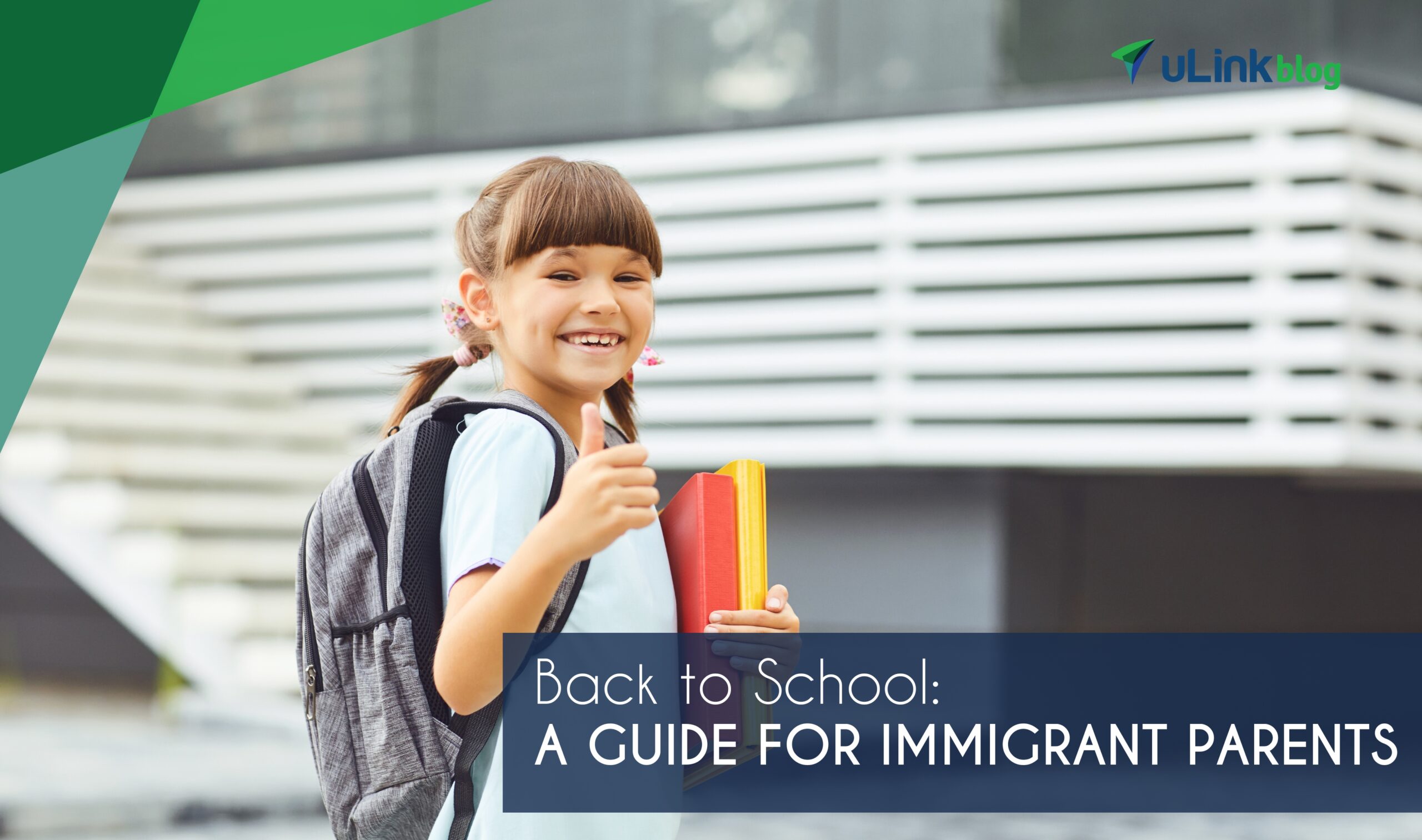
Sending your kids back to school can be stressful—especially if you’re an immigrant parent.
While solving transportation challenges and preparing for nightly homework, immigrant parents have an additional burden to bear: ensuring their children successfully assimilate into a new culture.
Here’s the good news: millions of immigrant parents have been where you are right now.
They have asked the same questions and encountered the same setbacks.
Thanks to their tenacity and leadership, they have helped their children through academia and into the working world.
The results are undeniable. From Fortune 500 CEOs to politicians to small business owners, once immigrants get settled in the U.S., they excel at remarkable rates. After all, 55% of America’s billion-dollar startups were founded by immigrants.
Today, we are going to look at how you can set your children up for success by embracing the season of “back to school” in the U.S.
Understanding “Back to School” in the U.S.
When the calendar changes from July to August, most Americans have one thought on their minds: summer is over.
That initial sense of dread is universal, as it signals a national return to work. While Labor Day marks the official kickoff of the work season on September 4, children are the first wave of autumn workers.
Their “back to school” journey often starts with shopping. Lots of shopping.
School supplies, new clothes, and fresh shoes are hallmarks of a dawning school season. In fact, it’s the “new” stuff that helps dull the pain of the dying summer.
Nevertheless, school can bring tremendous anxiety and anticipation for children. That’s true whether we are talking about a first-grader or a high-school freshman:
- What will they think of me?
- Am I “cool” now?
- I hope they like my new glasses!
When school finally starts, friendships will form, assignments will be given, and extracurricular activities will fill up calendars.
“Back to school” is clearly an overwhelming occasion, but don’t worry: the chaos will subside.
To help with your preparations, check out the following tips to encourage a smooth adjustment for you and your family.
“Back to School”: 3 Considerations to Keep in Mind
You know your family better than anyone, and the following tips aren’t meant to suggest that there’s one “right” way to approach school.
Instead, they’re designed to stimulate conversation.
Following these considerations, we’ll conclude with a brief word on academic success and the importance of the parent-teacher relationship.
1. Shopping Wisely: Saving Money on School Supplies
School supplies aren’t cheap, and rising inflation isn’t helping.
To mitigate the cost of school supplies, consider buying in bulk and splitting costs with other families.
For example, if you purchased a standalone backpack, notepads, pencils, and other utensils for your child, it would be difficult to keep the total price below $50.
However, if you bought those same items in bulk, you could significantly cut costs.
This backpack comes loaded with notebooks, folders, pencil cases, scissors, crayons and more. When purchased in bulk, it can cost as low as $15 per kit.
If splitting the cost with other families isn’t possible, that’s okay.
After all, any purchases made in bulk will last your family for many years of schooling. While it may require an upfront investment, you will save lots of money over time—especially if you have multiple children.
P.S. In our research, Staples seems to have the best prices for school supplies. For example, when you bundle multiple notepads, folders, and pencils, you’ll pay just $2 (not including taxes).
Want to learn more about budgeting for school? Click here for our complete guide.
2. Mental Health and Preparing Your Children for the School Year
At their best, schools facilitate learning, growth, and discovery.
Unfortunately, they can also foster anxiety, insecurity, and in some cases, bullying.
As a parent, you play an integral role in the mental and physical health of your children. While you can’t control the academic and social environment at school, you can ensure that your home is a refuge for open conversation.
We all remember what it was like to be young. And it wasn’t always easy.
While the world around us was changing, we were changing, too—inside and out.
As a parent, you have the unique opportunity to counsel your children and find out what they’re thinking, where they’re struggling, and where they’re excelling.
Ask open-ended questions early and often, including:
- What did you learn today?
- What was the best part of your day?
- Who do you get along with most?
- Did your classmates do anything funny?
- What nicknames do other children give you?
These questions also serve a secondary purpose: to ensure your child isn’t getting bullied or harassed.
The majority of kids don’t admit to getting bullied, and it can be easy to overlook their suffering—especially in a digital age where cyberbullying is so common.
If your child acknowledges that they are being bullied, it’s important to respond both quickly and compassionately. Assure them that they did nothing wrong and that you’ll make sure the bullying stops.
Then, inform a teacher or administrator at your child’s school and enlist their protection. If the situation merits it, you may also consider reporting bullying incidents to your local police.
To learn more about warning signs for bullying (and what to do about it), be sure to visit stopbullying.gov.
P.S. Mental health is an important subject, and it deserves as much conversation as possible. To that end, we recently compiled a comprehensive list of mental health resources exclusively for immigrants.
To learn more about what services and organizations are available to you, please click here.
3. Transportation: Utilizing Technology for Convenience and Safety
When it comes to student transportation, you have a number of options to consider.
You can drive your kids to school, participate in a local carpool, or have your kids take the bus.
If you live close to the school, your kids might even be able to walk.
Of course, no two living situations are the same, so you’ll have to make the best decision for your unique circumstances.
Maybe your bus system is the easiest option. Maybe other parents make carpooling the obvious choice. Or, maybe the school is on the way to your office, so driving makes the most sense.
Nevertheless, safety remains the #1 concern for every parent, and mobile apps make student transportation more reliable than ever.
For example, if your kids ride the bus to school, you can use a smartphone app that tells you exactly when they arrived at school (and once they’ve left school, how soon they’ll return home).
In other words, you’ll never have to guess where they are.
While each school district may utilize different GPS technology, most bus trackers function in the same way. Check out the free WheresTheBus app to see how it works.
Thankfully, buses aren’t the only mode of transportation to benefit from modern technology.
You can also take advantage of carpool apps to sync up with other parents and neighbors.
The best part is, these apps centralize parents schedules, bus routes, and carpool communications, so you and your network will always be on the same page.
Want to learn more? Be sure to check out popular apps like Carpool-Kids and GoKid, where over 1 million carpools have been successfully scheduled.
The Key to Academic Success: Investing in Parent-Teacher Relationships
Thus far, we’ve covered several fundamental approaches to saving money, protecting mental health, and streamlining transportation.
Before we wrap up, we’d like to briefly discuss the most fundamental element of school: succeeding in academics.
As we’ve already mentioned, it’s very important to know not only what your kids are studying, but also what they’re retaining.
While teachers are responsible for introducing subjects to your children—and testing them on that information—you’re responsible for ensuring they understand and internalize the material.
While you can’t set the curriculum (unless you decide to homeschool), you’ll be overseeing your children’s homework assignments, test scores, and grades.
Teachers start class at school; you finish it at home.
That’s why it’s so vital to develop a symbiotic parent-teacher relationship, so you know exactly how to help your kids learn.
Plus, teachers are constantly observing how your kids interact with others, so they can tell you how they’re developing in a group environment. If there are any issues with other students, or even a hint of bullying or foul play, they’ll be able to keep you informed.
Ultimately, report cards only tell half the story of your child’s education, but teachers can fill in the gaps. Be sure to visit them often and stay in touch throughout the year.
After all, investing in your children’s teachers is an investment in the children themselves.
P.S. If your child is struggling in a particular subject, consider hiring a tutor.
While tutors used to be quite expensive, you can now partner with vetted college students at top U.S. universities for just $20/hour at GoPeer (which also provides a free trial).
We also encourage you to check out Learn To Be, which connects underserved kids with 100% free, 1-on-1 online tutoring. Click here to learn more!
Moving Forward
As an immigrant parent, you have a lot to manage.
While adjusting to life in the United States, you’re tasked with ensuring that your kids receive a great education.
Though it’s tempting to worry about the future, stay focused on the present. Take each day as it comes, and remember that millions of immigrant families have been exactly where you are right now.
In summary, remember the following points of consideration:
- Save money on school supplies by buying in bulk.
- Split costs with other families (or save resources for future years of schooling).
- Leverage sites like Staples for individual purchases.
- Facilitate a perpetual dialogue with your kids about school.
- Ask open-ended questions to learn more about your child’s experience.
- Know how to spot signs of bullying and abuse.
- Leverage smartphone apps for school transportation (i.e. WheresTheBus and GoKid).
- Stay in close communication with your children’s teachers.
- Look for additional “teaching moments” in and around the house.
- Consider affordable (and free) tutoring resources like GoPeer and Learn To Be.
As always, uLink will be here to help you support your family back home.
While you adjust to life in the U.S., we’ll make sure you have access to great exchange rates and fees starting as low as $0—so you can send more money home than ever before.
Miles from home—just moments away with uLink.









